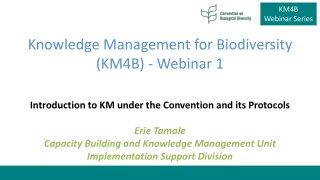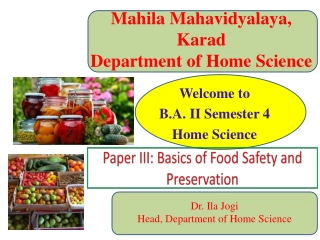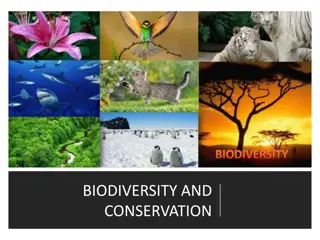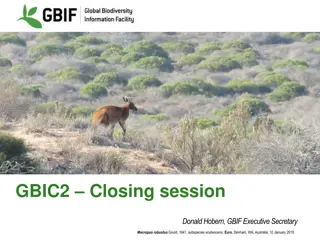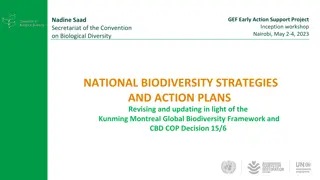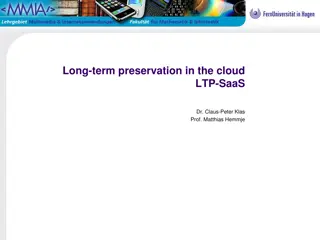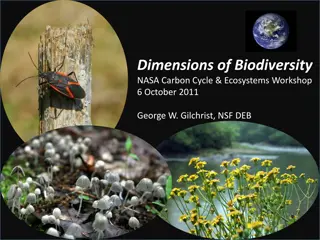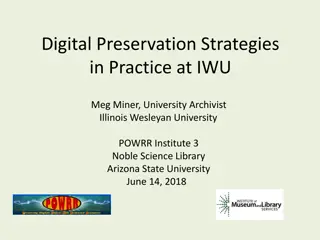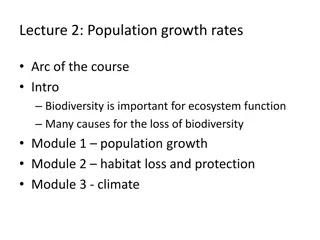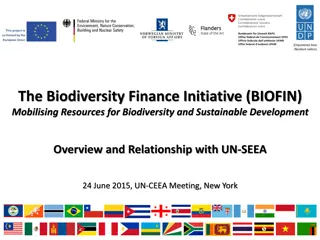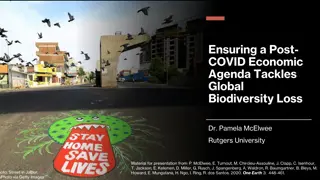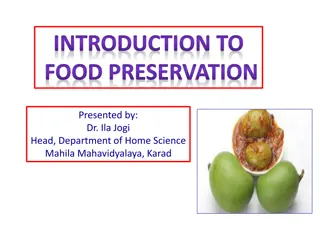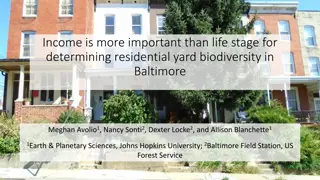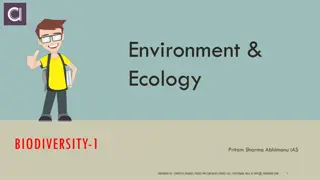Importance of Biodiversity in Environmental Preservation
Understanding the significance of biodiversity is crucial for maintaining a healthy environment. Biodiversity encompasses the range of species and organisms within communities, playing a vital role in sustaining ecosystems and food sources. Loss of biodiversity can have detrimental effects on various organisms, emphasizing the need for conservation efforts.
Download Presentation

Please find below an Image/Link to download the presentation.
The content on the website is provided AS IS for your information and personal use only. It may not be sold, licensed, or shared on other websites without obtaining consent from the author.If you encounter any issues during the download, it is possible that the publisher has removed the file from their server.
You are allowed to download the files provided on this website for personal or commercial use, subject to the condition that they are used lawfully. All files are the property of their respective owners.
The content on the website is provided AS IS for your information and personal use only. It may not be sold, licensed, or shared on other websites without obtaining consent from the author.
E N D
Presentation Transcript
LIFE SCIENCES GRADE 12CAPS STRUCTURED, CLEAR, PRACTICAL - HELPING TEACHERS UNLOCK THE POWER OF NCS KNOWLEDGE AREA: Environmental Studies TOPIC 5: Human Impact on the Environment Loss of Biodiversity
SUMMARY OF PRESENTATION: Importance of Maintaining Biodiversity Factors that reduce Biodiversity Factors that reduce the Loss of Biodiversity The Sustainable Use of the Environment
IMPORTANCE OF MAINTAINING BIODIVERSITY You already know the term biodiversity. Are you able to define this term???
IMPORTANCE OF MAINTAINING BIODIVERSITY Yes that s right Biodiversityrefers to The range species and the number of organisms making up the species within communities.
TERMINOLOGY: TERM: Biodiversity DEFINTION: USE IN SENTENCE: Refers to the range species and the number of organisms making up the species within communities The loss of biodiversity would lead to a shortage of food for the organisms.
IMPORTANCE OF MAINTAINING BIODIVERSITY Now this brings us to another term you already know Do you remember the definition of community???
IMPORTANCE OF MAINTAINING BIODIVERSITY Yes that is right! Communityrefers to a group of organismsof different species occupying the same habitat.
TERMINOLOGY: TERM: Community: DEFINITION: USE IN SENTENCE: A group of organisms of different species occupying the same habitat. Game reserves usually have a large number of different communities.
IMPORTANCE OF MAINTAINING BIODIVERSITY Since we already know what is biodiversity, what want to look at the importance of biodiversity. Here are some reasons why the biodiversity must be maintained
IMPORTANCE OF MAINTAINING BIODIVERSITY Plants and animals could provide us with additional foods, medicines and other products that will save lives and be useful in a changing climate. Biodiversity helps maintain important ecological processes such as oxygen production, pollination and flood control that in turn help support all life on Earth. a. b.
IMPORTANCE OF MAINTAINING BIODIVERSITY Our lives would not be as rich if we reduced biodiversity (aesthetic reasons). c. Biodiversity is important for recreation, for example camping, hiking, fishing and bird- watching. Conservation of species is important for future generations. d. e.
IMPORTANCE OF MAINTAINING BIODIVERSITY Unfortunately we are living in a period called the 6th major extinction! During this period many large animals have become extinct. Some examples include the woolly mammoth and the dodo. Therefore this period is also called the Mega faunal extinction Woolly Mammoth Dodo
IMPORTANCE OF MAINTAINING BIODIVERSITY Studies have shown that many species are at an extremely low level. And many species are in danger of becoming extinct. We now want to study the reasons for this loss of biodiversity.
FACTORS THAT REDUCE BIODIVERSITY The following factors may cause a reduction in biodiversity Habitat Destruction Poaching Alien Plant Invasions 1. 2. 3. Now lets look at each of the above in some detail
FACTORS THAT REDUCE BIODIVERSITY Habitat Destruction: 1. Habitat destruction is the process in which natural habitat is unable to support the species present.
FACTORS THAT REDUCE BIODIVERSITY It is caused by the following factors Poor farming methods that is monoculture and overgrazing Golf estates Mining Urbanization Deforestation Loss of wetlands and grasslands a) b) c) d) e) f)
FACTORS THAT REDUCE BIODIVERSITY Many of these factors have been discussed in previous sections. We shall look at the following
TERMINOLOGY: TERM: Habitat destruction DEFINITION: USE IN SENTENCE: is the process in which the natural habitat is unable to support the species present. Habitat destruction is another factor that leads to a loss of biodiversity
FACTORS THAT REDUCE BIODIVERSITY As the population increases more people move to the urban areas in search for food and a better lifestyle. This is called urbanization. The great influx of people to the urban areas leads to the need for more land for living, working and recreation. Therefore we find vast areas of land that are cleared to provide the land required for housing developments like complexes, Golf Estates.
FACTORS THAT REDUCE BIODIVERSITY The increase in population also increases the need for natural resources, such as coal, platinum and gold. This leads to the search for new land for mining. This usually leads to large scale destruction of land.
FACTORS THAT REDUCE BIODIVERSITY Poaching: b) Refers to the illegal capture or removal of plants and animals. We shall look at 2 types of poaching. These are Rhino poaching and Elephant poaching i. ii.
FACTORS THAT REDUCE BIODIVERSITY It may take place because of the following reasons a) Meat is used as food and the hides can be used for shelter or clothing. b) Bush meat provides exotic dishes for those people who want to try something new, the hides are often used to create pieces of clothing that are used as status symbols like furs.
FACTORS THAT REDUCE BIODIVERSITY Many plants and animals are used to make muthi. Different parts of the plants and animals are used. Vultures, cape fur seals, baboons and green mambas are some of the animals used in the muthi trade. c) vulture Green mamba Cape fur seal
FACTORS THAT REDUCE BIODIVERSITY d) Illegal selling of the plants or animals or their products bring large sums of money. Some examples are the cycads, the rhino horns and elephant tusks. Rhino horns Elephant tusks Cycads
FACTORS THAT REDUCE BIODIVERSITY Rhino Poaching i. There is an increase in the number of rhinos being poached. Most of these animals are being poached in the Kruger National Park, Limpopo and Kwa-Zulu Natal. Rhino
FACTORS THAT REDUCE BIODIVERSITY The increase is largely to supply the rhino horn market in the Far East. There is such a huge demand in these countries because it is believed that it can cure cancer and it is an aphrodisiac.
FACTORS THAT REDUCE BIODIVERSITY The police and the South African Government has tried to limit rhino poaching by More arrests Longer prison terms The use of DNA technology to track rhinos and their parts in an attempt to catch the poachers. These are actually solutions to the problem of rhino poaching. Learn them!!!! a) b) c)
FACTORS THAT REDUCE BIODIVERSITY Elephant Poaching Elephant poaching is also on the increase. The increase is brought about because of the demand for ivory that comes from the elephant tusks. These tusks fetch very high prices. In an attempt to reduce elephant poaching ivory trade has been banned both locally and internationally since 1989. This resulted in a slow increase of the elephant population because the demand for ivory decreased. ii.
FACTORS THAT REDUCE BIODIVERSITY Alien Plant Invasions: 3. Since we have already looked at the cause and effects of alien plant invasions we will not look at them now.
FACTORS THAT REDUCE THE LOSS OF BIODIVERSITY We will now look at some ways to reduce the loss of biodiversity. We will look at 2 examples of the way in which the loss of biodiversity can be reduced. These are The Control of Alien Plant Invasions The Sustainable use of the Environment 1. 2.
FACTORS THAT REDUCE THE LOSS OF BIODIVERSITY Control of Alien Plant Invasion Alien plant invasions can be controlled using mechanical, chemical or biological methods. Lets look at each one. 1.
FACTORS THAT REDUCE THE LOSS OF BIODIVERSITY Mechanical Control: In this case the alien plants are physically removed. They are removed by hand or by machines. Mechanical control may also include mowing and burning. These methods are effective in controlling small populations. They are often used because this method will not cause harm to the non-invasive plants and animals. But this method is time consuming and would require the farmer to employ labourers to do this. a)
TERMINOLOGY: TERM: Mechanical control DEFINITION: USE IN SENTENCE: Mechanical control is good because the non-invasive plants and animals are not harmed. refers to the removal of alien plants by hand or by machines
FACTORS THAT REDUCE THE LOSS OF BIODIVERSITY Chemical Control: In this type of control chemicals are used to prevent the spread of alien plants. They can be easily and effectively used in small and large areas. However it can also harm other plants and animals in the habitat. It can also contaminate the land and water in the area. The alien plants can also become resistant to the chemicals. b)
FACTORS THAT REDUCE THE LOSS OF BIODIVERSITY Biological Control: In this case the predator of the alien species is used to control the spread of the alien species. c) This method is very successful. It is also safe. But it must be done by a professional. If it is not done correctly it can get out of control. Examples of biological control are the use of insects, deliberately infecting plants with pathogens.
TERMINOLOGY: Term: Biological control DEFINITION: USE IN SENTENCE: The use of a natural enemy of the pest to control the pest population. Biological control is a safe and effective way of control the pest population.
THE SUSTAINABLE USE OF THE ENVIRONMENT It has become fashionable to use natural products. Medicines, make up, skin care products and food are all in greater demand if they are made of natural ingredients. These natural ingredients are usually plants or parts of plants. This has put an increased demand on certain species of plants. This has lead to the exploitation of these plants. Lets look at some of these examples.
THE SUSTAINABLE USE OF THE ENVIRONMENT Devil s claw 1. This is a plant found on the African Continent. The scientific name of the plant is Harpagophytum procumbens This comes from the Greek word harpagophytum meaning hook plant. Devil s claw
THE SUSTAINABLE USE OF THE ENVIRONMENT It was given this name because of its distinctive hook-like projections. These hook-like projections are the claws . Claws Devil s claw
THE SUSTAINABLE USE OF THE ENVIRONMENT The Devil s Claw was used by South Africans to reduce pain and fever. It was also used for curing digestive problems. Now Devil s claw is used for the following It is used for the treatment of joint pain caused by osteoarthritis, gout or rheumatoid arthritis. Also used for the treatment of muscle, tendons and ligament pain. It also assists in digestion. a. b. c.
THE SUSTAINABLE USE OF THE ENVIRONMENT Only the secondary root tubers are used for medicinal purposes. The tubers are large. They are chopped and dried before being processing into medicine. Tuber
THE SUSTAINABLE USE OF THE ENVIRONMENT Over use of the Devil s claw can lead to the extinction of the plant. However the following can be done to prevent the over-exploitation of the plant. The wild populations of the Devil s claw must be examined, to determine the size of these wild populations. This is done to ensure that these populations are not wiped out. The plant should be cultivate for the purpose of use as medicine. a. b.
THE SUSTAINABLE USE OF THE ENVIRONMENT Guidelines have been developed for the sustainable use of devil s claw. A proposal has been made to put the Devil s claw on the list of endangered species. c. d.
THE SUSTAINABLE USE OF THE ENVIRONMENT In another attempt to prevent the over- exploitation of the plant, guidelines were developed for the collectors of the plant. These are the guidelines Collect only the number of plants that are permitted by the authorities. Try to grow the plant near your home. Close the digging pits after harvesting, to allow any seeds left in the soil to germinate into new plants. Replant the primary root . a. b. c. d.
THE SUSTAINABLE USE OF THE ENVIRONMENT Collect the fruits and distribute the seeds so that there are more plants in the harvesting area. Tablets
THE SUSTAINABLE USE OF THE ENVIRONMENT 2. Rooibos: Aspalatus linearis is an endemic plant to South Africa. It is found in the Cedarberg Mountains. Rooibos plant
THE SUSTAINABLE USE OF THE ENVIRONMENT This plant requires deep sandy soils, cool moist winters and hot dry summers. The Cedarberg mountains provide all of the above Cedarberg mountains Rooibos tea is made from this plant.
THE SUSTAINABLE USE OF THE ENVIRONMENT Rooibos means red bush. From the previous picture you can see that the bush isn't red! It only turns red once it is dried. The leaves turn red because they have become fermented. Dried rooibos leaves
THE SUSTAINABLE USE OF THE ENVIRONMENT It was used as a herbal remedy by the Khoisan people a long time ago. These were the indigenous people of that area. But as these tribes started to decrease in numbers the medicinal knowledge of the rooibos was lost.
THE SUSTAINABLE USE OF THE ENVIRONMENT In the 18th century it was rediscovered by a botanist. But it was used as a refreshing drink. Many people enjoyed its sweet taste. They were not aware of its herbal uses.


